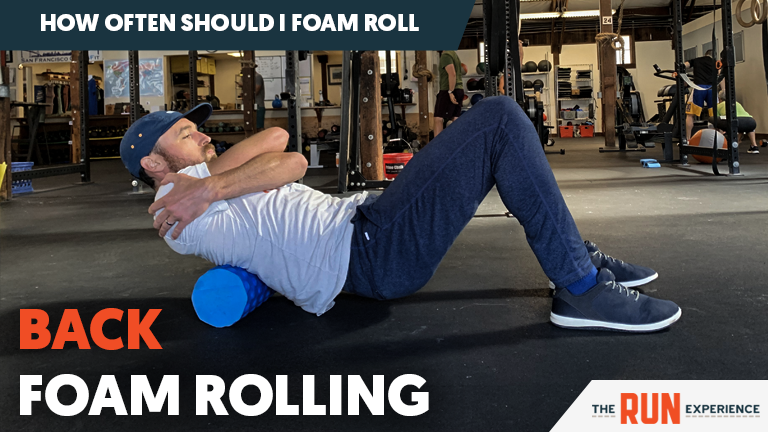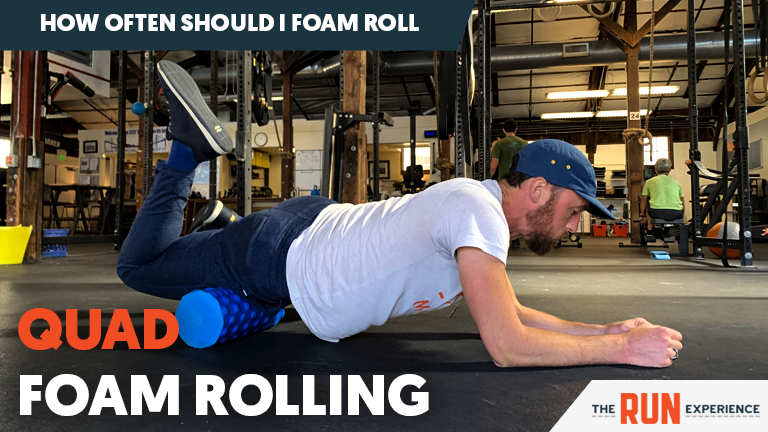Foam Rolling for Runners: How Often Should You Foam Roll?
Ever wonder how much foam rolling is too much or too little? Learn how often you should foam roll, and what are the benefits of foam rolling.

How often should you foam roll? With the recent growth in recovery tools, it begs the question of how often we should be using them. How much is too much? Is there too much?
Great questions. We have answers.
How Often Should You Foam Roll?
As a running coach, I get this question all the time. In fact, I just got it again last week from one of our 30-Day Challenge athletes.
“How do I know if I’m doing too much foam rolling? Or not enough? What’s the “RIGHT” amount?”
Rather than write something out, I decided to film a little video about how to use a foam roller the right way and identify your trigger points for where to roll. (I do this a lot for athletes in our programs!) So in this impromptu video, I address:
- What happens to your muscles when you foam roll and how you can use your body weight to your advantage
- Signs of OVER rolling (yes, you CAN do too much!)
- Specific guidelines for doing the “right” amount of this type of self-massage
What Is Foam Rolling?

Foam rolling—also known as self-myofascial release—is such a great topic because it’s the gateway drug to self-care and maintenance.
What? The term “self-care” doesn’t exactly blow your hair back? How about the ability to:
- Train as MUCH as you want
- Run as FAR as you want
- Race as FAST as you want
- Prevent muscle soreness, tight muscles, and injury–especially in your IT bands and other muscle groups, such as your glutes and hamstrings.
- Increase blood flow
Benefits of Foam Rolling for Runners
Foam rolling offers a range of benefits that can enhance your overall fitness and athletic performance. Here's a quick look at how incorporating this simple tool into your routine can make you a better runner:
- Muscle Recovery: Aids in breaking down muscle adhesions and scar tissue, promoting faster recovery and reducing soreness.
- Increased Flexibility: Improves the range of motion in joints by releasing tension and enhancing tissue elasticity.
- Injury Prevention: Maintains muscle elasticity and health, reducing the risk of strains, sprains, and other injuries.
- Enhanced Performance: Studies and expert opinions highlight that regular foam rolling boosts strength, endurance, and overall athletic performance by keeping muscles supple and functional.
How Much Is Too Much Foam Rolling?

The cornerstone to all of these things is consistent training. And the key to consistency is minimizing and eliminating ALL potential running injury!
Seeing how 80% of you will experience some kind of injury or setback this year, I know we all can do a better job here, so incorporate foam rolling into your post-workout routine.

So, check this video out to see if you’ve been foam rolling “right” or if you could (most likely) use a few tweaks and adjustments to prevent sore muscle groups, improve your range of motion, and enhance your overall self-care strategy!
When to Foam Roll?
Foam rolling has been embraced widely for its potential to aid in muscle recovery, improve flexibility, and mitigate muscle soreness. But when is the optimal time to incorporate foam rolling into your fitness routine?
Let’s explore the various contexts in which foam rolling can be beneficial.
1. Pre-Workout: For Activation and Mobility
- Purpose: Enhance blood flow, improve mobility, and prepare muscles for activity.
- How to: Focus on dynamic and fluid movements, spending a brief time (around 30 seconds) on each muscle group.
- Target Areas: Focus on areas that will be heavily utilized during the workout.
2. Post-Workout: For Recovery and Flexibility
- Purpose: Aid in the recovery process, reduce muscle soreness, and improve flexibility.
- How to: Spend more time (up to 1-2 minutes) on each muscle group, moving slowly and focusing on areas that feel particularly tight or sore.
- Target Areas: Prioritize muscles that were heavily engaged during the workout.
3. On Rest Days: For Maintenance and Well-being
- Purpose: Maintain muscle health, enhance overall flexibility, and promote relaxation.
- How to: Adopt a gentle and mindful approach, spending adequate time on each muscle group without causing discomfort.
- Target Areas: Focus on any areas that may feel tight or sore, and don’t neglect often-overlooked regions like the upper back or adductors.
4. During Workouts: For Transition and Reset
- Purpose: Reset muscles during transition periods or between different exercises.
- How to: Briefly roll targeted areas between exercises or sets to alleviate tension and prepare muscles for subsequent activities.
- Target Areas: Focus on muscles that may feel fatigued or overworked during the workout.
5. Before Bed: For Relaxation and Sleep Quality
- Purpose: Promote relaxation, alleviate muscle tightness, and potentially enhance sleep quality.
- How to: Adopt a slow and gentle approach, focusing on relaxation rather than intensive muscle release.
- Target Areas: Prioritize muscles that may feel tense or tight, and consider focusing on the back and shoulders to promote overall relaxation.
6. Upon Waking: For Activation and Alertness
- Purpose: Activate muscles, enhance morning mobility, and promote alertness.
- How to: Engage in brief and dynamic rolling, focusing on major muscle groups and areas that might feel stiff upon waking.
- Target Areas: Consider focusing on the back, hips, and legs to counteract any stiffness from sleep.
7. During Prolonged Sitting: For Circulation and Alertness
- Purpose: Promote blood circulation and alleviate muscle stiffness during prolonged sitting.
- How to: Engage in brief and gentle rolling, focusing on alleviating tension without causing disruption.
- Target Areas: Focus on the lower back, hips, and legs which may become particularly stiff during prolonged sitting.
Specific Foam Rolling Techniques for Different Muscle Groups
Foam rolling specific muscle groups can target tightness and improve overall mobility. Here’s how to effectively roll different areas of your body:
Quads and Hamstrings:
- Quads: Lie face down with the foam roller under your thighs. Use your forearms to support your upper body and roll from the top of your knees to your hips.
- Hamstrings: Sit with one leg extended over the foam roller and the other bent for support. Roll from your knee to your glute.
- Benefits: Relieves tension and improves flexibility in the front and back of your thighs, essential for running and other leg-intensive activities.
IT Band and Glutes:
- IT Band: Lie on your side with the foam roller under your outer thigh. Use your hands for balance and roll from just below your hip to just above your knee.
- Glutes: Sit on the foam roller with one ankle crossed over the opposite knee. Lean slightly towards the glute you're rolling and use your hands for support.
- Benefits: Reduces tightness in the outer thigh and buttocks, helping to prevent knee and hip pain.
Calves and Shins:
- Calves: Sit with your legs extended and the foam roller under your calves. Lift your body slightly with your hands and roll from your ankles to just below your knees.
- Shins: Kneel on the floor with the foam roller under your shins. Roll from just below your knees to your ankles.
- Benefits: Eases tension and improves mobility in the lower legs, which is crucial for activities like running and jumping.
Back and Shoulders:
- Back: Lie on your back with the foam roller under your upper back. Cross your arms over your chest or support your head with your hands. Roll from your upper back to mid-back.
- Shoulders: Lie on your side with the foam roller under your armpit, extending towards your rib cage. Roll gently in small movements.
- Benefits: Relieves tension in the upper body, improves posture, and helps prevent upper back and shoulder pain.
Can You Foam Roll Too Much?
While foam rolling can be a beneficial tool, excessive use or incorrect techniques can potentially lead to issues such as:
- Bruising: Overzealous or prolonged foam rolling can cause bruising, especially on sensitive or thinly-muscled areas.
- Over-irritation: Excessive rolling might irritate the muscles and fascia, potentially leading to inflammation.
- Discomfort or Pain: Particularly for individuals with certain health conditions, too much pressure or rolling can cause discomfort or exacerbate pain.
To utilize foam rolling effectively without veering into the territory of overuse, consider the following:
- Duration: Limit foam rolling sessions to approximately 10-15 minutes and avoid spending more than 20-30 seconds on one particular muscle group.
- Intensity: Apply moderate pressure, ensuring that any discomfort felt is tolerable and not crossing into pain.
- Technique: Ensure your technique is correct, focusing on slow, controlled movements and avoiding rolling over joints.
- Frequency: While daily foam rolling can be beneficial, listen to your body and consider reducing frequency if you notice any adverse effects.
- Alternating Areas: Consider alternating between different muscle groups on different days to avoid overworking one area.
Incorporating Varied Recovery Methods
While foam rolling can be a valuable component of your recovery toolkit, it should be complemented with other strategies, such as:
- Stretching
- Adequate hydration and nutrition
- Sufficient sleep
- Possibly incorporating other recovery tools like massage guns or compression therapy
Start Foam Rolling With Our App
Want help monitoring how often to foam roll and how to long to do it? We’ve got you covered.
P.S. Download our new mobile app full of tips, videos, training advice, and motivation to get you started. Don’t forget to check out our broad range of training programs to help you reach your running and fitness goals, too!

